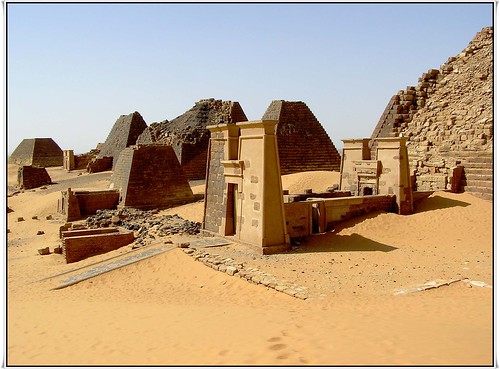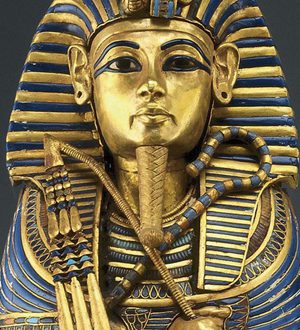 The Nubians get short shrift when it comes to recognition of significant ancient cultures. A new exhibition at the Clay Center in West Virginia, US, hopes to rectify that. It is cleverly entitled: Lost Kingdoms of the Nile, but the artefacts are all Nubian, not Egyptian. (The subtitle is: Nubian Treasures from the Museum of Fine Arts Boston.) The exhibition runs from Sept. 12, 2009 to April 11, 2010.
The Nubians get short shrift when it comes to recognition of significant ancient cultures. A new exhibition at the Clay Center in West Virginia, US, hopes to rectify that. It is cleverly entitled: Lost Kingdoms of the Nile, but the artefacts are all Nubian, not Egyptian. (The subtitle is: Nubian Treasures from the Museum of Fine Arts Boston.) The exhibition runs from Sept. 12, 2009 to April 11, 2010.
Part of the problem for the Nubians, of course, is the rock-star quality of their neighbors, the Ancient Egyptians, who persistently dominate the imaginative landscape when it comes to ancient things. Most of us have to wrack our brains to make the distinction. Nubians have been ignored until recently, said Barbara Racker, Curator at the Clay Center. There was a major exhibition in 1976, and then the Museum of Fine Arts Boston opened a gallery dedicated to Nubian culture in the early 1990s, but it was subsequently closed to make space for other collections.
TheEgyptians and the Nubians
So, whats the difference? Heres the deal: Nubia was a Nile River-based culture, but further up the Nile from Egypt, deeper into Africa, stretching from Aswan to Khartoum in what is now Sudan. They had gold, which was an advantage over the neighboring Egyptians, but they also had cataracts six major rapids in the Nile which meant the river did not form the extraordinary highway that enabled the easy growth of trade and cultural exchange that it did in Ancient Egypt. The first phases of Nubian culture, named A-Group and C-Group by George Reisner, stretches from 3100 BC to 1500 BC and became much more powerful in subsequent periods – Kerma, Napatan and Meroitic. A treaty with the Romans around 23 BC allowed the Nubians to outlast the Egyptians, as Racker likes to point out. The Nubian civilization was impressive through the Meroitic period which ended about 350 AD.
 Until three decades ago, Nubians were considered lesser than Egyptians, says Racker. But weve a lot to learn, still. What we do know is that Nubia had a troubled relationship with Egypt; often enemies, sometimes slaves, at one point even united into a single Kingdom. Because Nubians were superior bowmen, they were often used as protectors for Egyptian royalty. But this is ironic, Racker points out, since Nubians invented the concept of kingship. They made fabulous pottery a thousand years before their neighbors to the north , and they were superior engineers, too, discovering the importance of leverage before the Egyptians, allowing them to make much steeper, although smaller, pyramids.
Until three decades ago, Nubians were considered lesser than Egyptians, says Racker. But weve a lot to learn, still. What we do know is that Nubia had a troubled relationship with Egypt; often enemies, sometimes slaves, at one point even united into a single Kingdom. Because Nubians were superior bowmen, they were often used as protectors for Egyptian royalty. But this is ironic, Racker points out, since Nubians invented the concept of kingship. They made fabulous pottery a thousand years before their neighbors to the north , and they were superior engineers, too, discovering the importance of leverage before the Egyptians, allowing them to make much steeper, although smaller, pyramids.
But they admired the Egyptians greatly, says Racker. When Nubia took over and ruled the whole of Egypt and Nubia for 60 years during the 25th Dynasty (760-656 BC), it was to the Egyptian past that they turned for inspiration. They wanted to recreate the glory and grandeur of the former Egypt, explains Racker. So it was really a renaissance culture.
The Exhibition of Nubian Culture
The exhibition, which contains 200 artefacts and a great deal of interpretative material, is mostly from the collection at the Museum of Fine Arts in Boston, including objects from the royal tombs of el Kurru, Nuri, and Mero which date from the Prehistoric Period to the Roman era (3100 BC to 246 AD). Sculpture, stone relief elements, gold and silver jewelry, ceramic and alabaster vessels, and other items illustrate ancient Nubian art, funerary customs, warfare, and daily life, uncovering the rich and diverse aspects of one of the worlds great, yet often overlooked civilizations. The highlight of the show is not from Boston, but from the Michael C. Carlos Museum in Atlanta, Georgia, which has loaned the Coffin of Neskashuti, (Dynasty 25, 760-656 BC). This colorful coffin belonged to a priest (Divine Father of Min) named Neskashuti. The broad facial features and sculptural design are typical of coffins of the Nubian Dynasty, which Racker points out is a true black African culture, unlike the Ancient Egyptian one. Until the mid-20th century, many historians didnt accept that Nubians leaders were black because the civilization was too sophisticated, says Racker. Even the eminent archaeologist, George Reisner, didnt understand this; he believed that Nubia kings were light-skinned Egypto-Libyans.
 The aim of this exhibition, explains Racker, is to give the visitor a better understanding of Nubian culture, and to see that its not lesser to Egypt. They adopted customs and art from Egypt but were different in a lot of ways.
The aim of this exhibition, explains Racker, is to give the visitor a better understanding of Nubian culture, and to see that its not lesser to Egypt. They adopted customs and art from Egypt but were different in a lot of ways.
Even more exciting, there are traces of Nubian culture alive today, especially in music, which is played at the exhibition. Visitors are treated to tracks from modern-day musicians including Mahmoud Fadl, Hamza-El-Din, and Ali Hassan Kuban.
The 5,000 sq. ft. exhibition is laid out chronologically in 36 cases, some of them very large. The last part features artifacts from the Adena culture in West Virginia, which is one of the oldest in North America, running from 1,000 BC to 1 AD. It includes tools, a clay pipe and copper jewelry and, for Racker, is a great way to bring visitors back to the ancient history of the land in which theyre viewing these extraordinary evidences of an important culture far away in time and space.





